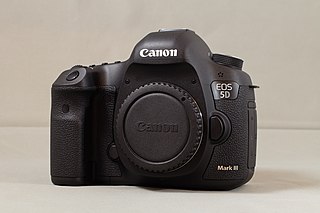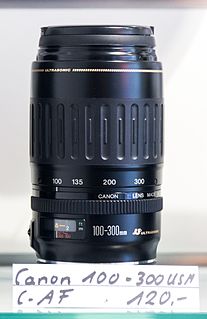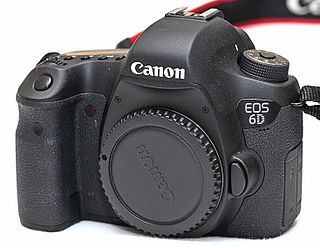This article needs additional citations for verification .(August 2015) (Learn how and when to remove this template message) |
The EF 35-105mm lens is a family of EF mount wide-to-normal zoom lenses manufactured and sold by Canon. There were three versions made. The first version was released in 1987 as an f/3.5 - f/4.5 aperture lens. [1] The next was released in 1991 as a f/4.5 - f/5.6 aperture lens. [2] The last version was released in 1992 as a f/4.5 - f/5.6 USM version. [3]

Introduced in 1987, the EF lens mount is the standard lens mount on the Canon EOS family of SLR film and digital cameras. EF stands for "Electro-Focus": automatic focusing on EF lenses is handled by a dedicated electric motor built into the lens. Mechanically, it is a bayonet-style mount, and all communication between camera and lens takes place through electrical contacts; there are no mechanical levers or plungers.

In photography and cinematography, a wide-angle lens refers to a lens whose focal length is substantially smaller than the focal length of a normal lens for a given film plane. This type of lens allows more of the scene to be included in the photograph, which is useful in architectural, interior and landscape photography where the photographer may not be able to move farther from the scene to photograph it.
In photography and cinematography, depth compression and expansion with shorter or longer focal lengths introduces noticeable, and sometimes disturbing, distortion while a normal lens is a lens that reproduces a field of view that appears "natural" to a human observer.
On several recent high-end Canon EOS bodies, including the EOS 7D Mark II, [4] EOS 5D Mark III and EOS-1D X, the f/4.5–5.6 versions of this lens are treated for the purpose of autofocus as if they were f/8 lenses, limiting AF functionality to the center point (and surrounding four points if AF Point Expansion is enabled) only. They are the only lenses without an extender attached that are treated this way.

The Canon EOS 7D Mark II is a professional digital single-lens reflex camera made by Canon. It was announced on September 15, 2014 with a suggested retail price of US$1,799. It features a 20.2 effective megapixel APS-C CMOS sensor, Full HD video recording at 60 fps, 10.0 frames per second continuous shooting, a 100% accuracy viewfinder which offers 1× magnification. It also features a 65-point auto-focus system, a built-in Speedlite transmitter and a new 150k RGB pixels + IR metering sensor. It was preceded by the Canon EOS 7D.

The Canon EOS 5D Mark III is a professional grade 22.3 megapixels full-frame digital single-lens reflex (DSLR) camera made by Canon.

The Canon EOS-1D X is a professional digital SLR camera body by Canon Inc. It succeeded the company's previous flagship Canon EOS-1Ds Mark III and the Canon EOS-1D Mark IV. It was announced on 18 October 2011.










